The OnePlus 7 Pro Review: Outstanding Performance & Screen, Adequate Everything Else
by Andrei Frumusanu on June 19, 2019 12:00 PM EST- Posted in
- Mobile
- Smartphones
- OnePlus
- OnePlus 7 Pro
Display Measurement
The screen of the OnePlus 7 Pro is definitely the key feature of the phone. The 6.67” 3120 x 1440 resolution panel not only represents OnePlus’ highest resolution display to date, but the 90Hz display mode also makes it stand out above any other smartphone currently available.
Display Architecture: 90Hz - But How?
In our article covering the phone’s announcement, a big question for me was exactly how OnePlus had achieved the running of 1440p90 in terms of hardware implementation between the SoC and the panel DDIC. Initially I had theorised that OnePlus would have had to employ a dual-MIPI interface, doubling up on the hardware connections between the two chips.
To my surprise when investigating the device’s kernel source, this actually isn’t the case, and the OnePlus 7 Pro still only has a single MIPI interface to the DDIC. After a bit of research, the only explanation I have is that this must be one of the very first devices in the market which is implementing a newer D-PHY physical layer standard in the MIPI DSI interfaces. The SoC and DDIC must be using either a new D-PHY 1.2 or D-PHY 2.0 standard with much increased data transfer rates.
I was actually quite surprised by this and it’s generally excellent news for the phone as it means the hardware implementation was done in the most optimal way, as opposed to the less efficient dual-interface implementation on some other phones.
I did try to measure what the actual power drain of the screen was, but wasn’t able to get to quite as straightforward results as I wanted. Measuring input power into the phone, the device’s base drain was in line with last generation devices at ~550mW in 60Hz mode. Oddly enough turning on 90Hz had a large effect on the drain and increased base power by ~100mW.
Measuring the power on the device’s internal PMIC however showed good figures in line with the Galaxy S10 at a lower ~400mW, and no noticeable difference between the 60 and 90Hz modes. We’ll revisit this discussion later on in the battery results page, but for the moment I’m more inclined to believe the former (worse) numbers given the results I’ve achieved.
Display Measurement
The device’s screen gamuts are implemented in the traditional style with multiple pre-defined profiles. There’s a “Vivid” mode which goes beyond the DCI P3 standard, and there’s an accurate “Natural” mode that is also colour managed for Display P3 and sRGB content much like on the Galaxy S10.
On top of these, OnePlus also gives an “Advanced” option with sub-selections of the AMOLED, P3 and sRGB gamuts with a custom colour temperature slider. These later modes are quite a disappointment as we’ll see shortly.
As always, we thank X-Rite and SpecraCal, as our measurements are performed with an X-Rite i1Pro 2 spectrophotometer, with the exception of black levels which are measured with an i1Display Pro colorimeter. Data is collected and examined using SpectraCal's CalMAN software.

In terms of maximum brightness in manual mode, the OnePlus 7 Pro achieves up to 399 nits on full-screen white, which is in line with other phones which have dedicated high brightness modes in “Auto”. It’s to be noted that OnePlus here is quite a bit brighter than Samsung’s phones.

When high brightness mode is enabled under high ambient luminosity in the Auto mode, the OnePlus 7 Pro boosts up to ~548 nits. I was a bit surprised at this figure as it is well below OnePlus’ advertised figure of 800 nits at 100% APL. I again dug a bit deeper into the drivers of the panel and saw that the hardware isn’t allowed to go over 670nits in HBM. After further digging I discovered that the brightness behaviour in the Vivid mode is quite different and this actually even activates APL brightness scaling; here the phone is able to reach around the 670nits figure at 100% APL.
So although brightness of the phone’s display isn’t really an issue, it’s not quite as bright as advertised, and it also doesn’t quite reach the levels of some other phones by the competition when in accurate colour modes. Legibility in direct sunlight as captured above in the picture is still very good.
We’re measuring Grayscale accuracy in the device’s most accurate default mode; the “Natural” mode. At 200 nits brightness, the phone is showing good results. The biggest issue I see is that it’s veering off towards the warmer side with an average CCT of 6013 – the blues are clearly too weak in this display mode. The core issue here is that colour temperature over brightness isn’t quite linear and the brighter you get, the nearer to the target 6500K you get.
Gamma accuracy is also good, although just slightly above the target 2.2 mark at 2.36 average. The average is pulled up due to the first and last 10% of levels being too dark.
OnePlus had advertised an odd minimum of 0.27 nits in brightness which I had time to comprehend at the beginning. Indeed this mode is only available when enabling “Night Mode 2.0” on the phone, which is essentially the blue light filter mode. Without this, the phone’s minimum white brightness is a regular 1.88nits which is in line with what we see in the industry.
Again we’re seeing black clipping at the lowest intensity levels of the phone. Currently only Apple’s iPhone X and XS series are the only OLED devices on the market to able to handle this characteristic correctly.

Overall the phone’s greyscale accuracy is good and in general most people won’t notice any issues in the “Natural” mode of the phone.
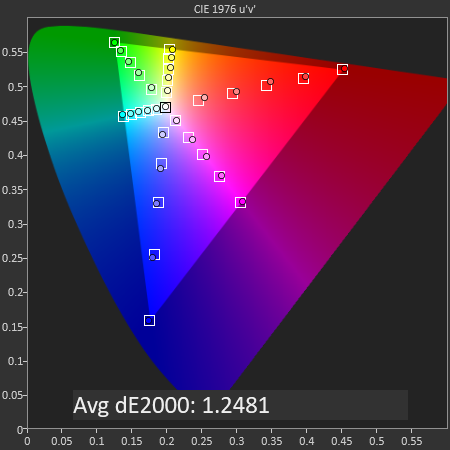
SpectraCal CalMAN
Natural Mode (sRGB)
In terms of saturation accuracy of the phone, we also measure the Natural mode as the most accurate profile, but I want to take a second to showcase an oddity of the phone’s Advanced mode in a second.
In the Natural mode, the phone was excellent saturation accuracy results with a deltaE2000 of 1.24, with only slight deviations in the lower red intensity levels.
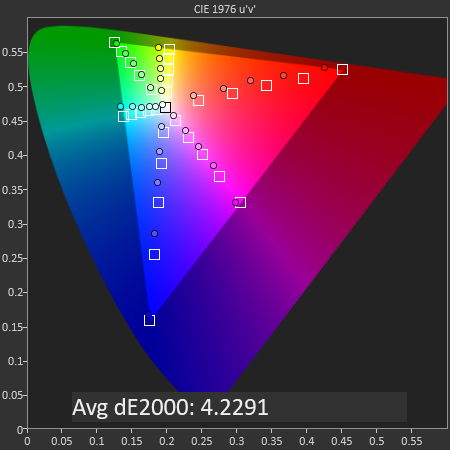
SpectraCal CalMAN
Advanced Mode sRGB
What’s really confusing is that the phone’s “Advanced” mode really isn’t that advanced. First of all the default colour temperature in this mode is very much off and too blue. For the above measurement I tried to get as close to accurate whites as I could with the slider (Slider around the 80% mark), however the results were still massively disappointing with results being quite over the place, resulting in a bad dE2000 of 4.22.
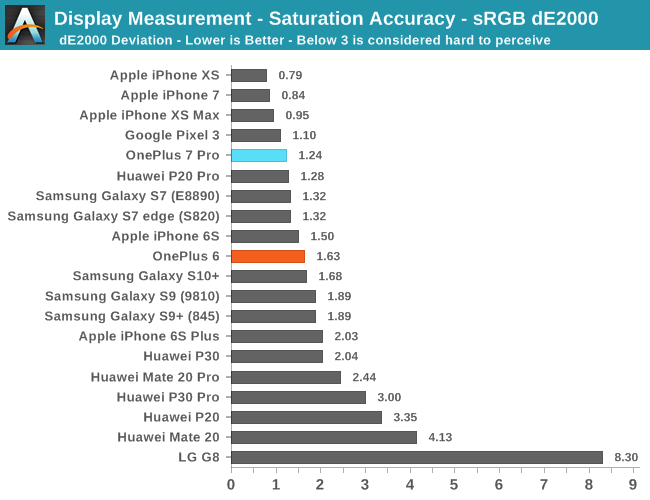
Nevertheless, I recommend the Natural mode and thus the display accuracy of the OnePlus 7 Pro in this regard ends up as extremely competitive and among the top performers.

The Display P3 gamut is also available under the Advanced modes, although this mode also needed tuning to get to an acceptable colour temperature, and while the saturation accuracy was better than the sRGB mode, it still showcases some of the same deviations in the greens and reds and thus ends up with a dE2000 of 3.14 (yay for Pi).
In the Gretag-Macbeth chart of common colours such as skin-tones, the OnePlus 7 Pro ends up with excellent results with a dE2000 result of 1.63. There’s some devices that still beat it, but overall it’s still a fantastic result and should result in visually imperceptible differences to consumers.
Display Conclusion
Overall, the OnePlus 7 Pro’s display is excellent. While it doesn’t really break any records, OnePlus was able to currently deliver the best Android screen this year, besting even Samsung in terms of calibration.
While there’s always room for improvement, the only other issue I’d talk about is that the screen’s side curvature is quite of a larger radius than what we’ve seen from other more recent phones adopting this design. This does result in more reflections.



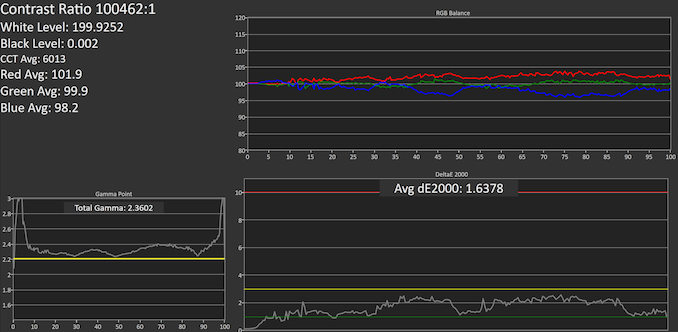

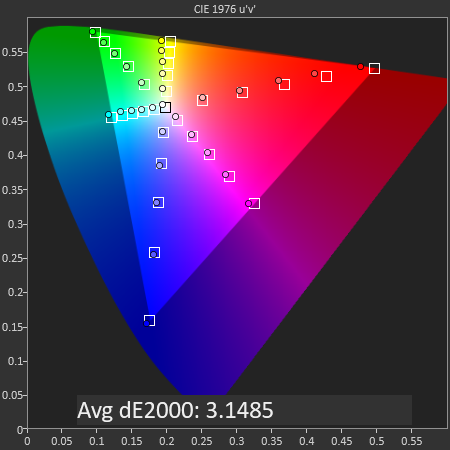
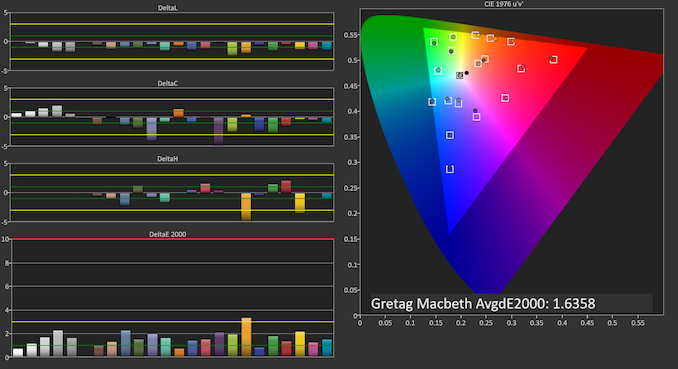










91 Comments
View All Comments
DillholeMcRib - Wednesday, June 19, 2019 - link
Can I flash this damn thing and run WIndows ARM on it?Jez1 - Wednesday, June 19, 2019 - link
I had this around a week and they were great things about it, but many things I didn't like so returned it.The screen was great and apps installed at an amazing pace, the UI was lovely but to many negatives. The camera was so erratic and one minute would take a nice photo, then the next would have washed out colors and lacked detail and sharpness when slightly zoomed in. A lot of the time my old S7 took more reliable photos and my wife's 6T was also better. I know this could get better with fixes, but was too poor out of the box.
The sides of the screen also got massive reflections outside and the inbuilt screen protector was rubbish. In a week of light use, it was covered in indention's from my nail and also stated getting air bubbles. So you couldn't even appreciate the lovely screen and there wasn't any 3rd party ones available.
The final thing which is subjective is the weight, it felt so heavy one-handed.
I then got a s10+ and and couldn't be happier with in comparison. I got a big discount for my old bashed up S7, so only paid £40 more. I hope OnePlus can get it together for their next phone as love their approach and really didn't want to get another Samsung
Quantumz0d - Wednesday, June 19, 2019 - link
With this phone OnePlus went full marketing mumbojumbo.They spent a lot of cash on that only and while sidetracking all the negatives this phone has. 90Hz is a gimmick, so many people don't want that. Instead they want a phone which is marked at $700 these -
- A 3.5mm headphone jack, (How come the 6T dropped the jack saying no space for the finger print scanner while they crammed a motorized camera into the chassis, It's plain BS as always with Apple or any company, Note had S-Pen, LG has Display fused OLED crystal sound with proper ToF camera with an ESS DAC equipped phone)
- No SD card slot, No don't say cloud or 256GB, I have a ton of data on my PC FHD high bitrate movies, 4K UHD recording directly to SD card pictures to SD card, High quality recording of Audio through Stereo and high bitrate likes of LG, Emulators, FLAC/DSD files etc and top of all, a fully reliable offline cheap storage which just works and offers expansion as per user choice from 128GB to 1TB.
- No IP rating, No the damn shilled tests from Dave2D or MHBHD aren't going to cut it, the IEC conventions are internationally agreed standards not some bs offscreen tests saying it increases price and all rubbish kool-aid.
- Trash camera
- No QI wireless charging, glass back and peanuts charging, they don't wnat to give because they want to milk with all these features barring the jack for another refresh or new unit.
- No price cuts, OP phones never get a price cut, today you can buy an SD835 (By no means a problem) phones like S8+ for 500USD which has everything more than this gimmick phone, LG phones see price cuts, got my V30S for far less price under 500USD which outperforms in all features, Yes even the BL unlock, coming to that, S9 and Note 9 are cheaper at $600USD which again rape this phone to oblivion esp Exynos models which have BL unlock. And the latest S10 is already seeing discounts, and once Black Friday hits the G8 and all phones will drop price.
Next is Zenfone6 that phone is making waves apart from the mediocre LCD display (No pentile, so FHD is fine but the brightness is not enough) and it has 3.5mm jack, Stereo speakers, a big arse 5000MaH battery without this over charging current rate.
Huge thanks to Andrei a lot for this piece on this stupid overdrive current charging done by Oneplus, fools at many blogs and youtube shills refuse to believe me that over high currrent charging is insane simply due to the cathode-anode reactions and faster degradation, esp this is why we need Qi not battery raping marketing BS. These oneplus garbage phones always overcharge and do this rubbish, look at QC with Samsung/LG/Sony any company apart from this and Huawei have that, Apple even sandbags the battery death by reducing the CPU perf. This BS is not seen my 99% of the people and they end up with junk on top of the non user replaceable batteries.
So all in all this is an overpriced "toy" not a proper pocket PC / Powerful computer in your hand.
Quantumz0d - Wednesday, June 19, 2019 - link
Edit - Zenfone 6 specs include - it also got UFS storage unlike Pixel 3a with eMMC trash, an SD855 a great camera than this junk well, at-least from the users, an SD slot, Bootloader unlock and highest SKU is less than 600USD (8GB/256GB)zodiacfml - Thursday, June 20, 2019 - link
I agree especially on the LCD display. I have a lot of praise for OLED until I got it for the first time in the S8+. It is easily not as sharp as my Nexus 5. Every time I open the Nexus 5, I'm taken away how sharp and clean the display is versus the AMOLED S8. I have late 30's eyes. I'd rather take an LCD display for my next phone as long it is reasonably priced vs premium OLED phones.I disagree with your fast charging criticism though. I'm no battery enthusiast, if rapid charging kills batteries, then we should not see them in electric vehicles such as Tesla cars.
My Nexus 5 doesn't have rapid charging tech but my second battery is, again, bulging with less capacity. It does heat a lot though with Data turned and/or during gaming. Certainly, it is heat is the detrimental effect and heat is only the effect of fast charging
Andrei Frumusanu - Thursday, June 20, 2019 - link
> if rapid charging kills batteries, then we should not see them in electric vehicles such as Tesla cars.Tesla batteries are also gigantic (In comparison to a regular wall outlet power) and designed to handle that.
We've had a smartphone vendor who promoted one of these super-high charging rate confirm some pretty atrocious long-term capacity degradation, while something like Samsung's degradation curve was like 20% higher in terms of retained capacity after the same amount of cycles.
zodiacfml - Thursday, June 20, 2019 - link
I refer to Tesla's Superchargers where a Model 3 can charge to 80 percent in 30 minutes. A Supercharger charges its battery cells as fast as quick charging smartphones.OP can afford a faster charging rate than Qualcomm's QC because there is no voltage conversion happening in OP's phone, thus less heat. The only drawback only works with OP's charger and thick cable.
rabidpeach - Tuesday, June 22, 2021 - link
sorry it's been years but hopefully the future readership realizes that TESLA herself encourages you to NOT supercharge the car constantly as that would increase the degradation as well as well-reported constant fleet usage of supercharge style system has shown degradation.Xyler94 - Thursday, June 20, 2019 - link
I will always prefer my AMOLED displays in phones. OLEDs have the advantage of having much higher contrast than LCD, because individual pixels can be turned fully off, creating true black. There's no LCD that can do that. LED LCDs come close, but only because you can turn off zones of the LED backlight.Also, colour calibration makes an image look better than the display tech. If the Nexus 5 had better calibration, then it would definitely be a better display. I know Samsung TVs always have too much blue (I've calibrated a few of them), it's possible their phone displays have a bit too much blue too.
zodiacfml - Thursday, June 20, 2019 - link
That's what I thought which led me to buy the Samsung. I realized, the infinite contrast has little value to me except watching movies in darkness.The sharpness of the LCD over the pen-tile AMOLED is noticeable with text, sharper edges with LCDs. Images from my DSLRs or conventional cameras are also sharper on the N5.
White background in AMOLED never convinced me, feels rough or dirty. I checked today, looked at my Samsung around 4 inches away, I can notice multicolored very tiny noise-like pixels.
The Nexus 5 has one of the best calibrated displays during its time. I'm just saying LCDs superior to AMOLEDs in image sharpness alone